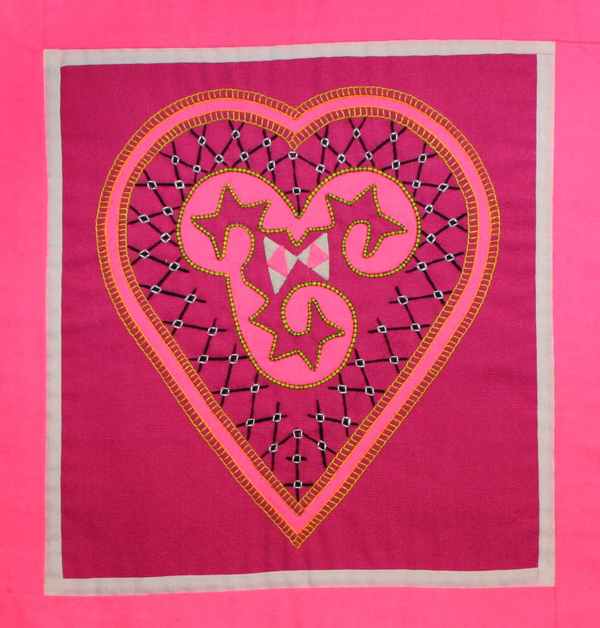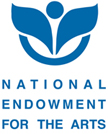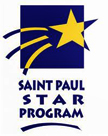Reverse Appliqué |
|---|
 |
R11: This reverse appliqué has as its main motif a ram’s head. It combines the spiraling curves of the snail with a right angle. Other motifs include the steps, and peacock cellous. Like most reverse appliqué pieces, it was cut to create a mirror image.
|
Back to Top |
 |
R12: This piece displays a reverse appliqué square. A piece of red cloth is folded into quadrants and cut, and then sewn onto the green background with a plain blanket stitche technique, making it symmetrical. The green motifs shown on this piece are heart motifs, done back to back. The white motifs involve steps. The white and blue flower satin stitches serve as embellishments. The dotted white lines in the middle of the green channels are running stitches, which represent seeds. The satin stitches in white and blue are flowers. Reverse appliqué squares are typically made for the specific commercial purpose of sales to foreigners and tourists.
|
Back to Top |
 |
R13: This is an appliqué and reverse appliqué artwork. The motifs are hearts with dragon tail motifs inside. Each heart is decorated with couched herringbone stitches to create fences around the dragon tails. In the red channels of the hearts, ladder stitches are used to hold the appliqué down. Small triangle appliqués decorate each side to act like a frame.
By Mai Thao, 1990, 35x35 cm |
Back to Top |
 |
R14: This piece displays both appliqué and reverse appliqué techniques. The heart design is the primary motif, but a secondary motif involves the dragon tails pictured in the center.Curved and spiral similar to the snail motif, they differ as a result of their sharp edges. There are two pink appliqué triangles on top of two white triangles in the center, decorated with couched
By Mai Thao, 1980s, 24x23 cm |
Back to Top |
 |
R15: This piece was completed using the reverse appliqué technique. The motif involves a star with overlapping chevrons, further decorated with pinwheel embellishments, and a blue and gold peacock ocellus motif in the center. Satin stitches were utilized for the seeds.
By an unknown artist, 2004, 13x13 cm |
Back to Top |
 |
R16: This is a reverse appliqué piece that displays a twinkling star design with an overlapping extension. It is decorated with designs that represent the red and green peacock ocellus. Blue and purple appliqué methods were utilized to construct the frame and borders. |
Back to Top |
 |
R17: This reverse appliqué has a sunshine motif. Each channel has dotted running stitches representing seeds. At the four corners, a single step motif is appliquéd in white, with three flower motifs sewn in green and pink. In the center, chain stitches form a chicken eye motif. The gray center panel cloth is also used for the border.
|
Back to Top |
 |
R18: This is a circular reverse appliqué, cut and sewn onto a blue background. The motif is sunshine. The rays of sunshine draw the viewer in. This is a hemmed piece, possibly a table decoration to be used under a bowl or vase.
|
Back to Top |
 |
R19: This is a reverse appliqué piece created using the motif of eight cucumber seeds. The seeds were cut to fill in the entire square and resemble flower petals. The white and maroon star-like motifs are sewn in satin stitches onto the blue cloth. They represent leafy green flowers. The blue cloth utilizes the overlay or reverse appliqué technique, and background is in grey.
|
Back to Top |
 |
R20: This piece also displays a reverse appliqué technique with a cucumber seeds motif, cut to fill in the entire square and resembling a flower of eight petals. The white and red chain stitched circles signify chicken eyes, while the center is a square with a chicken eye motif.
|
Back to Top |
Page 1 << Page 2 >> Page 3 |



